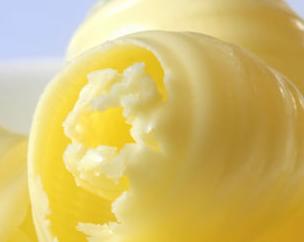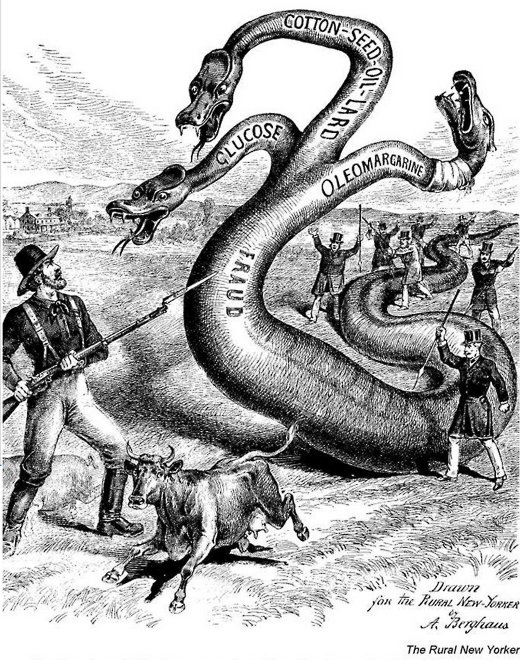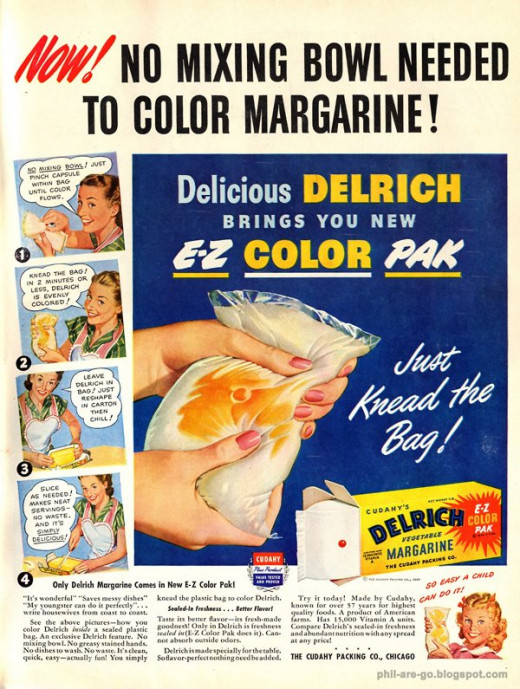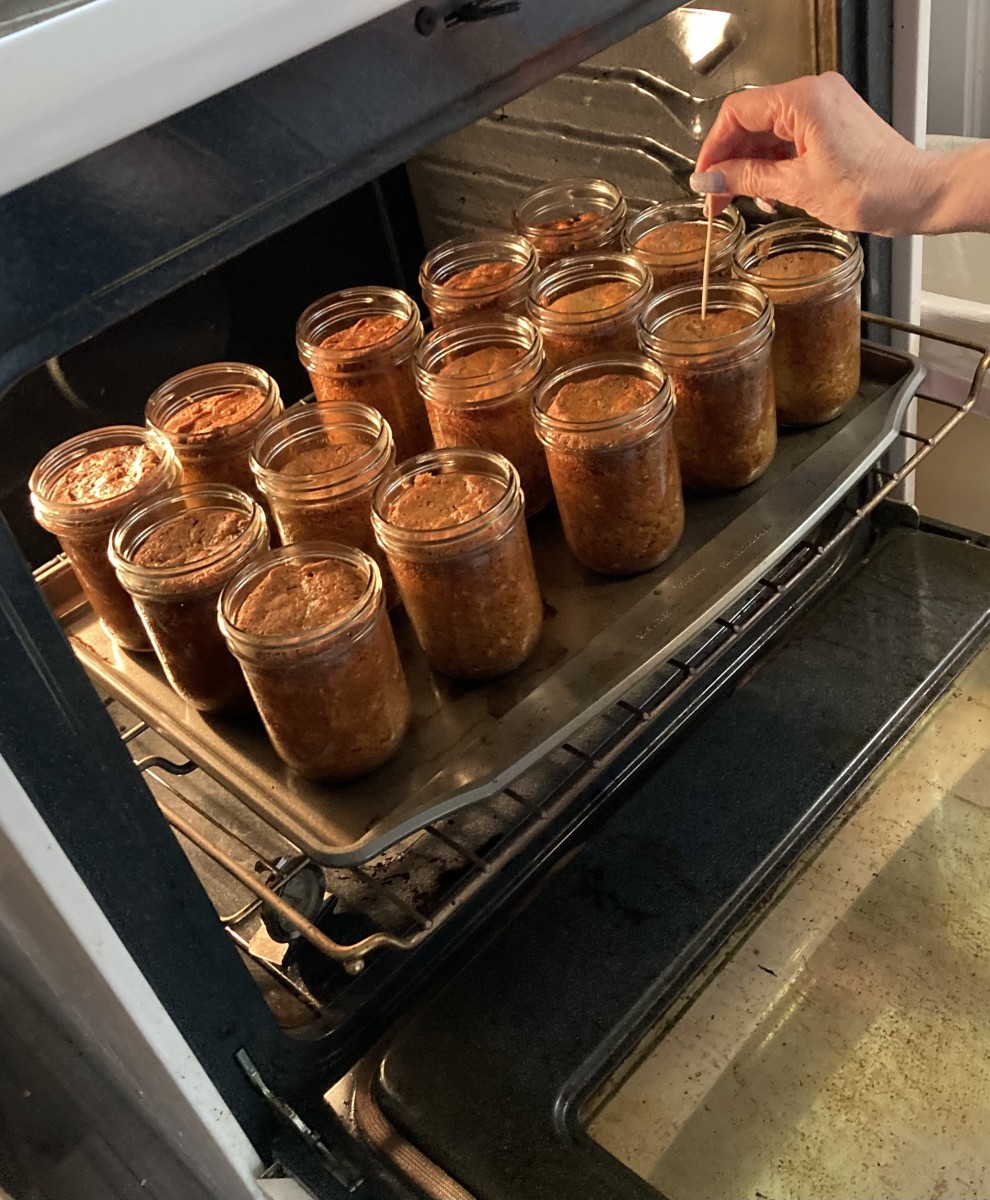A short history of Margarine - The Butter vs. Margarine Wars

While the pros and cons of butter vs. margarine continue to this day, the development of margarine production has a very interesting and rocky history.
Margarine had its genesis in the late 1860’s, when King Louis Napoleon III of France proposed a challenge for anyone to come up with a less expensive equivalent to butter. The chemist, Hippolyte Mège-Mouriès was up for the challenge (and the grand prize too of course). He took a pound of beef tallow (melted animal fat), soaked it in a solution of 15 percent regular table salt and 1 percent sulfate of soda, cooked it slowly at 103 degrees Fahrenheit, adding some gastric juices of a pig (…seriously!), sprinkled with some biphosphate of lime. He spun this curdled concoction in a centrifuge, then added a bit of cream. Surpisingly, this opalescent, jelly-like substance tasted much like butter. He named it ‘oleomargarine’, or margarine for short, after the greek term for pearl – ‘margarites’. He patented the invention of margarine in 1869. He sold the patent two years later to a Dutch company (Jurgens) who developed it further, and he died in relative obscurity many years later.
The Stigma of Using Margarine
Since margarine was cheaper to produce than butter, for years it had a sort of stigma as being a butter substitute for poor people. These ‘poor’ (or more correctly, frugal) customers were embarrassed to be seen purchasing margarine in the presence of customers who were more ‘well off’. However, margarine use increased during World Wars I and II, and the Great Depression, mostly because of rationing..making margarine an affordable, and to many people a quite palatable, substitute. The ‘poor’ stigma was starting to wear off.
A War of Words
For quite some time, margarine was viewed with suspicion. However, early on, in most countries, it was allowed with some restrictions, mostly to discourage any fraudulent sale of margarine masquerading as butter. Margarine is normally produced to a white color, so it was possible to add food coloring to make it yellow, like butter.
In 1873, a U.S. patent for margarine production was issued, and a number of companies started producing margarine in the early 1870’s. Many dairy producers feared that margarine that was made to look like butter would lead to the same fraudulent ’imitation butter’ that was feared abroad. A war of words, claims, counterclaims, legislation, and outrageous disinformation ensued, and lasted almost a hundred years in some locales.
In the late 1800’s the U.S. was still a largely agricultural society, and any food product that was not come by naturally, was viewed as just plain wrong. With these strongly held beliefs, it’s no wonder margarine was viewed as the devil’s work.
Many states, including Wisconsin (often dubbed ‘the dairy state’), enacted legislation to levy a separate tax (and in some cases an outright ban) on colored margarine..anywhere from 5 cents to 15 cents per pound, while uncolored margarine was either exempt, or a minimal tax. A federal bill called the “Grout Bill” after the representative, William Wallace Grout of Vermont, was enacted in 1902, which put the above restrictions on margarine in place across the U.S.
In Wisconsin, the rhetoric was (and for quite some time, remained) at an all time high. The following eloquent, but misguided speech by senator Joseph Quarles is quite revealing of the mind set at the time:
"Things have come to a strange pass when the steer competes with the [dairy] cow as a butter maker. When the hog conspires with the steer to monopolize the dairy business, it is time for self-respecting men to take up the cudgels for the cow and defend her time-honored prerogatives... We ought not now to desert her or permit her to be displaced, her sweet and wholesome product supplanted by an artificial compound of grease that may be chemically pure, but has never known the fragrance of clover, the freshness of the dew or the exquisite flavor which nature bestows exclusively on butter fat to adapt it to the taste of man... I desire butter that comes from the dairy, not the slaughterhouse. I want butter that has the natural aroma of life and health. I decline to accept as a substitute caul fat, matured under the chill of death, blended with vegetable oils and flavored by chemical tricks".
-Senator Joseph Quarles, addressing the U.S. senate on March 27, 1902
from ‘Wisconsin’s Fight over the Demon Spread’, by Gerry Strey, Wisconsin Magazine, Autumn 2001, via www.wisconsinhistory.org

The Color Barrier
In the early 1900’s, the process of hydrogenation was developed, to enable vegetable oils to be made into a more consistent solid form, much like butter. The use of animal fats in the production of margarine was gradually reduced or eliminated.
The issue of colored margarine wouldn’t go away so easily, however. In Wisconsin, for many years (into the mid 1960’s), it was illegal to sell colored margarine or serve it in restaurants. At several points, it was suggested that margarine should be colored pink or brown…to easily distinguish it from butter. Fortunately, such wild notions were struck down. The laws were difficult to enact however, and consumers who wanted margarine, often traveled to border towns to buy it out of state, and ‘smuggle’ it in. Such was the ridiculous state of things in those days.
Margarine was sold as white (much like shortening), along with a small packet of food coloring, since it wasn’t illegal for consumers to make their own yellow margarine at home. It was cheaper too, since it was minimally taxed. I well remember my mother mixing the food coloring into the margarine. You had to be careful about not letting the food coloring splatter, since it stained easily. I had a go at mixing it myself a couple of times. This home mixing of margarine lasted until the late 1960’s, it seemed to me.

Lifting the Restrictions on Margarine
These restrictions lasted much longer in Canada. Colored margarine was not ‘officially’ legal in Canada until 1995, although the laws were seldom enforced. In Quebec, however, dairy lobbyists successfully kept the laws on the books until 2008.
Throughout the 1950’s and 60’s, U.S. margarine laws were gradually repealed. Wisconsin was the last state to repeal the restrictions on the sale of colored margarine, in July 1967, though some taxes remained on margarine until 1975. Soft margarine in plastic tubs was introduced in the early 1970’s, and other spreads such as “I Can’t Believe It’s Not Butter” were introduced in the late 1970’s.
I hope you enjoyed this interesting tale of suspicion, intrigue and downright foolishness on the part of humans. Even though this tale is an old one, the foolishness and disinformation, and hyper reactions are still in full force on other fronts. There will always be politicians and others, who just love to hear themselves talk, and to twist the facts to fit their personal agenda. Life goes on…
This article copyright (2012) by timorous+





